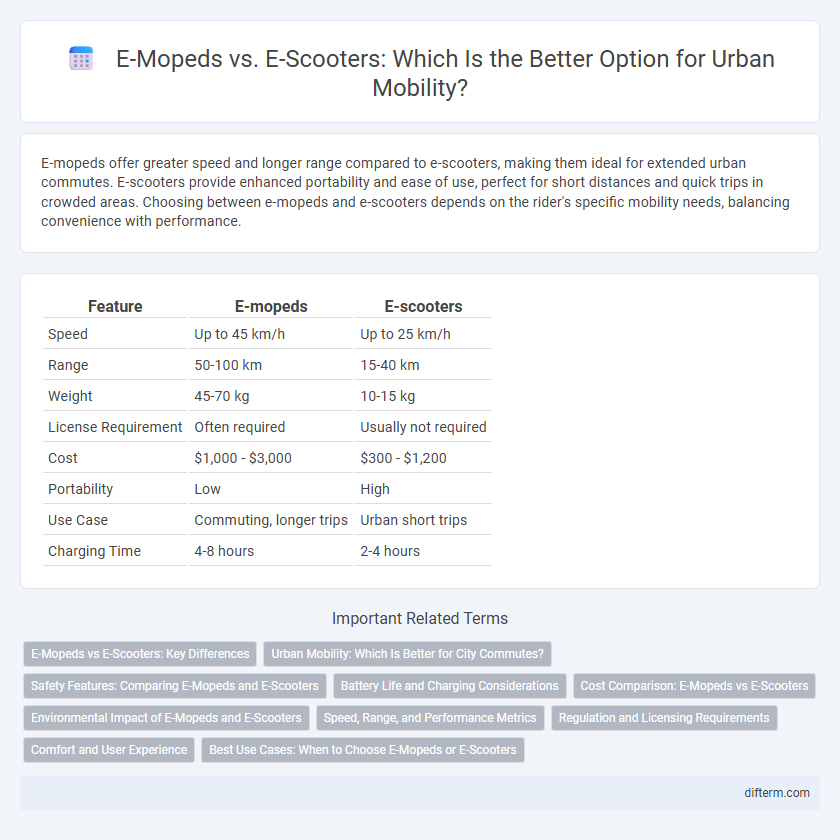E-mopeds offer greater speed and longer range compared to e-scooters, making them ideal for extended urban commutes. E-scooters provide enhanced portability and ease of use, perfect for short distances and quick trips in crowded areas. Choosing between e-mopeds and e-scooters depends on the rider's specific mobility needs, balancing convenience with performance.
Table of Comparison
| Feature | E-mopeds | E-scooters |
|---|---|---|
| Speed | Up to 45 km/h | Up to 25 km/h |
| Range | 50-100 km | 15-40 km |
| Weight | 45-70 kg | 10-15 kg |
| License Requirement | Often required | Usually not required |
| Cost | $1,000 - $3,000 | $300 - $1,200 |
| Portability | Low | High |
| Use Case | Commuting, longer trips | Urban short trips |
| Charging Time | 4-8 hours | 2-4 hours |
E-Mopeds vs E-Scooters: Key Differences
E-mopeds typically feature larger wheels, higher top speeds around 30-45 mph, and longer ranges up to 50 miles compared to e-scooters, which generally max out near 15-20 mph with shorter ranges of 10-20 miles. E-mopeds often require a license and registration due to their classification as motor vehicles, whereas e-scooters tend to have more lenient regulations, allowing easier urban use without extensive legal requirements. Battery capacity, motor power, and stability are key distinguishing factors, making e-mopeds better suited for longer commutes and rougher terrains, while e-scooters excel in lightweight, flexible, short-distance travel.
Urban Mobility: Which Is Better for City Commutes?
E-mopeds offer greater speed and range, making them ideal for longer urban commutes and varied traffic conditions, while e-scooters provide superior maneuverability and easy parking for short trips in congested city centers. Battery capacity and weight significantly influence the choice, with e-mopeds typically having larger batteries that support extended travel, whereas e-scooters emphasize portability and convenience. Ultimately, the decision depends on commute distance, urban infrastructure, and personal mobility needs in dense metropolitan environments.
Safety Features: Comparing E-Mopeds and E-Scooters
E-mopeds typically incorporate enhanced safety features such as robust frames, larger wheels, and advanced braking systems, offering greater stability compared to the lighter, more compact e-scooters. E-scooters often include basic safety mechanisms like LED lights, electronic brakes, and speed limiters but lack the structural protection found in e-mopeds. Regulatory standards for e-mopeds usually mandate stricter safety compliance, contributing to their superior protective measures in urban mobility contexts.
Battery Life and Charging Considerations
E-mopeds generally offer longer battery life compared to E-scooters, with typical ranges of 40 to 60 miles per charge versus 15 to 30 miles for E-scooters, making them more suitable for extended urban commutes. Charging times vary widely, yet E-mopeds often require 4 to 8 hours for a full charge, whereas E-scooters can charge in 2 to 4 hours, impacting daily usability and convenience. Battery capacity and the availability of portable or swappable batteries are key factors in choosing between these electric mobility options for users prioritizing endurance and quick turnaround times.
Cost Comparison: E-Mopeds vs E-Scooters
E-mopeds generally have a higher upfront cost, averaging between $1,000 and $3,000, compared to e-scooters which typically range from $300 to $800. Maintenance expenses for e-mopeds are also greater due to more complex components like brakes and batteries designed for longer distances. Energy consumption costs favor e-scooters, which use less electricity and charge faster, reducing overall operational expenses.
Environmental Impact of E-Mopeds and E-Scooters
E-mopeds and e-scooters offer environmentally friendly alternatives to traditional gasoline-powered vehicles, emitting zero tailpipe emissions and reducing urban air pollution. E-scooters typically have smaller batteries and lighter frames, resulting in lower energy consumption per mile compared to e-mopeds, which use larger batteries to support higher speeds and longer ranges. However, the production and disposal of lithium-ion batteries in both e-mopeds and e-scooters pose environmental challenges related to resource extraction and recycling infrastructure.
Speed, Range, and Performance Metrics
E-mopeds typically offer higher top speeds ranging from 25 to 45 mph, outperforming E-scooters that average between 15 and 20 mph, making them more suitable for longer commutes. In terms of range, E-mopeds can travel up to 60-80 miles on a single charge, while E-scooters generally cover 15-30 miles, influencing daily usability and charging frequency. Performance metrics such as acceleration, payload capacity, and stability favor E-mopeds, which support heavier riders and rougher terrains compared to the lighter, more portable E-scooters.
Regulation and Licensing Requirements
E-mopeds typically require a valid driver's license and registration due to their higher speed and engine power, whereas e-scooters often have more relaxed regulations, sometimes only mandating age restrictions or speed limits. Regulatory frameworks vary by region, influencing where e-mopeds can be ridden--usually on roads--while e-scooters are commonly restricted to bike lanes or sidewalks. Understanding local transportation laws is essential for compliance and safety when choosing between e-mopeds and e-scooters.
Comfort and User Experience
E-mopeds offer enhanced comfort with larger seats, better suspension, and more stable riding positions compared to E-scooters, making them suitable for longer commutes. E-scooters prioritize portability and ease of use, often sacrificing cushioning and ergonomic design, which can lead to less comfortable rides on uneven surfaces. User experience with E-mopeds tends to be smoother and less tiring, while E-scooters appeal to short-distance urban travel with quick acceleration and maneuverability.
Best Use Cases: When to Choose E-Mopeds or E-Scooters
E-mopeds excel in longer commutes and cargo transport due to their higher speed and robust build, making them ideal for urban workers or delivery services. E-scooters offer superior portability and ease of use for short trips, crowded city streets, and last-mile connectivity. Choosing e-mopeds suits those needing range and durability, while e-scooters fit quick errands and flexible urban mobility.
E-mopeds vs E-scooters Infographic

 difterm.com
difterm.com